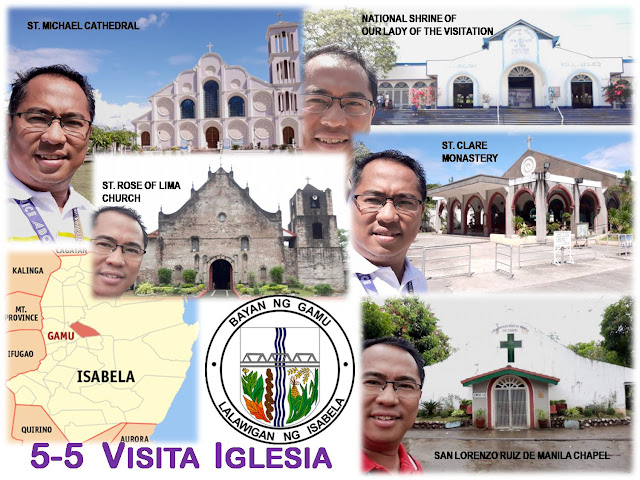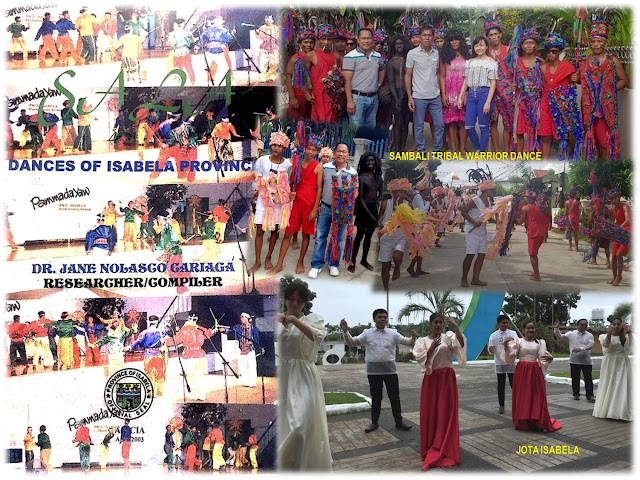64. 5-5 VISITA IGLESIA DE GAMU
5-5 VISITA IGLESIA DE
GAMU
Dr. Troy Alexander G. Miano
25 March 2018
The local chief
executive of the Municipality of Gamu, Isabela came up with a faith tourism
program for tourists and day-visitors especially during the Semana Santa or
Mahal na Araw which is the most significant religious observance for the
country’s Roman Catholic majority and most Protestant groups. The Visita
Iglesia or the Seven Churches Visitation is a pious Roman
Catholic Lenten tradition to visit seven churches on the evening of Maundy
Thursday after the Mass of the Lord's Supper where the Blessed
Sacrament is placed on the Altar of Repose for Adoration. The
pious and able would double the number of churches to fourteen, while the
infirm and elderly usually visit only one or a handful. Until the 1970s, people
recited all fourteen stations in every church, but the more recent form is to
pray two stations per church. The more devout would carry a cross to each
church, while others consider the ritual an opportunity for sightseeing. An
offering is usually made at each church and to the poor as a form
of almsgiving. To accommodate the faithful, many Catholic churches
during Holy Week remain open until midnight. Nowadays, it is common to
perform Visita Iglesia on any day during Holy Week. In the old pueblo
of Gamu, five Catholic churches can be found within the five-kilometer radius,
thus, the “5-5 Visita Iglesia”. They are the Cathedral of Saint Michael the Archangel,
Saint Rose of Lima Parish, National Shrine of Our Lady of the Visitation, Poor
Saint Clare Monastery and the Chapel of San Lorenzo Ruiz de Manila.
Gamu was originally
composed of three missions during the Spanish evangelization in the 1600s:
Itugod, founded in 1678 and now barangay Lenzon; Gamu – also known as the 2nd
Batavag founded in 1686 in memory of the 1st Batavag; and Furao, founded in
1740 and now a barangay of Gamu. In 1741, a little north of the confluence of
the Magat and Cagayan Rivers, now the present poblacion, the new town of Gamu was established by Dominican Fray
Martin Hernandez with inhabitants coming from the abolished towns of Batavag
and Itugod under the patronage of Saint Rose of Lima. The two pueblos were
abolished because of their small population, insufficient tributes to administer
the two towns and only with a few hands to work in the needed infrastructures.
In 1779, the fusion of the missions of Gamu and Furao was approved permanently.
Gamu was the seat of the mission and Furao became one of its barrio. The
territories of the municipalities of Naguilian (1896), Aurora (1927), San
Manuel (1937), Roxas (1948), Burgos (1967) and Quirino (1967) were once a part
of the vast pueblo of Gamu.
The “5-5 Visita
Iglesia” of Gamu has the mission statement: “Ginugunita at pinagninilayan ang Anak ng Diyos sa kanyang natatanging Misteryo ng pagpapakasakit at kamatayan sa panahon ng Undas na taun-taong
ipinagdiriwang ng Kristyanong pamayanan.” (Yearly, during the Holy Week, the Christian
community commemorates and meditates on the unique mystery of the sacrifice and
death of the Son of God).
I was able to experience
the “5-5 Visita Iglesia”. Starting from the south and since I came from
Cabatuan, my first stop was the National Shrine of Our Lady of the Visitation
of Guibang which houses the Miraculous Lady of the Visitation. The Shrine comes
alive on July 1st of every year when religious pilgrims from all
walks of life come to offer their prayers of thanks to God through Mary the
Mother. The image of Our Lady of the Visitation was canonically crowned by the
Most Rev. Carmine Pocco, Papal Nuncio to the Philippines on May 26, 1973 at the
St. Ferdinand Cathedral in Ilagan. The Catholic Bishops Conference of the
Philippines at its 52nd Bishop’s annual meeting held in Tagaytay
City on January 24-26, 1986 had approved the petition of His Excellency, Most
Rev. Miguel Purugganan, Bishop of Ilagan, for the Church of Our Lady of the
Visitation of Guibang to be called a National Shrine.
Adjacent to the
Shrine is the Chapel of Poor Saint Clare Monastery. Six missionary nuns from
their mother monastery in Cabuyao, Laguna responded to the invitation of Most
Rev. Miguel Puruggunan DD, Bishop of Ilagan, for the establishment of Poor
Clare in the diocese. A contemplative house in Guibang on January 9, 1991 was
erected and the cornerstone of this concrete monastery was laid on January 16,
1992. On May 31, 1996 the church was blessed and opened to the public.
Heading north, my
next visit was the Chapel of San Lorenzo Ruiz de Manila located inside Camp
Melchor F. Dela Cruz 5th Infantry Division of the Philippine Army situated
along the National Highway in Barangay Upi. The chapel was named after the
First Roman Catholic Saint of the Philippines, Saint Lorenzo Ruiz de Manila who
preferred death by execution rather than renounce his Christian faith in Japan
on September 23, 1637. After three and a half centuries, Ruiz was beatified and
canonized a saint in Rome on October 18, 1987 and his feast day is on September
28.
My fourth stop was
not located along the national highway. I need to turn left going to Mallig
Plains via Burgos-Roxas and another left heading for Gamu town proper to reach
the Saint Rose of Lima Parish. Compared to the other Spanish-era Isabela
churches, this religious edifice is more austere and quaint with its facade
quite simple and decorated with a few bas relief of which notable are the
Dominican Order symbols at the arch framing at the main entrance. The church’s
facade is made of layered bricks and stones dating back to 17th
century. Although it is small, this Spanish architectural designed edifice made
of bricks is ideal for mass celebration, weddings, baptism and a respite for
those who wanted to meditate and reflect solemnly because of the town’s serenity.
The feast of Saint Rose of Lima, the patronal saint of Gamu town, is celebrated
on the 23rd of August.
The last of my 5-5
Church Visit is the Cathedral of Saint Michael the Archangel, formerly known as
Saint Ferdinand Cathedral which is located along the national highway going to
the City of Ilagan. The seat of the Roman Catholic Diocese of Ilagan was
inaugurated on May 12, 2003. The Mother Church has a floor area of 2,400 square
meters which can accommodate 2,000 parishioners. The construction started in
1999 and along the sides of the church is the history of the diocese and the
salvation which are depicted in 16 mural-sized oil paintings. In 2013, the
episcopal seat of the Roman Catholic Diocese of Ilagan was transferred from the
Saint Ferdinand Parish Church in Bagumbayan, City of Ilagan to Barangay Upi in
the town of Gamu in reference to the decree by Pope Francis. The decree also
re-dedicates the Cathedral to Saint Michael the Archangel and in honor of
Bishop Miguel Gatan Purugganan, although the diocese remains under the
patronage of Saint Ferdinand of Castile.
It has been my yearly
vow to visit churches particularly Spanish period structures to pray and observe
the Holy Week. Isabela province has its own share of old churches in Alicia,
Cauayan, Gamu, Ilagan, Tumauini and San Pablo and influx of Catholics are
always expected during this period. Gamu town’s “5-5 Visita Iglesia” is not
tailored for Gamueños alone but to all faithful around the country and around
the globe who wish to pray and meditate on the Passion of Jesus Christ.




Mga Komento
Mag-post ng isang Komento